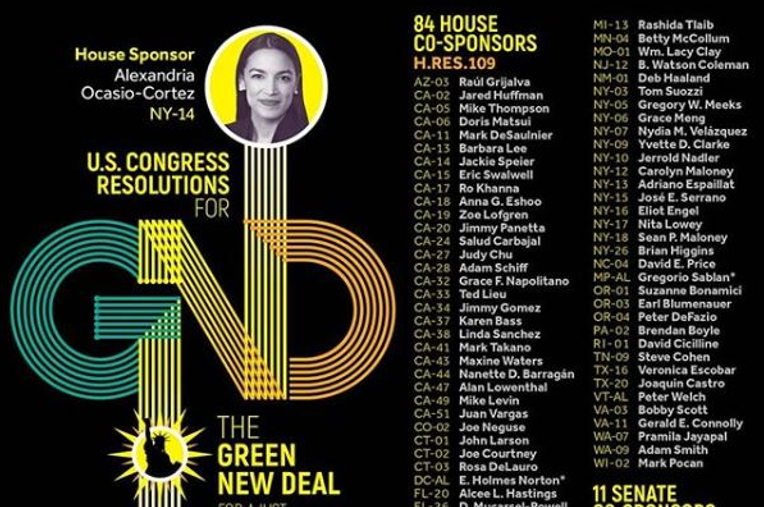Why does the proposal for a Green New Deal spark so much passion in the United States? The 14-page resolution, presented to the US Congress on February 7 by Representative Alexandria Ocasio-Cortez and Senator Ed Markey, proposes sweeping changes to the principles guiding the action of the US federal government. This analysis shows that while the ecological aspects of the proposal are fairly conventional, the political dimension represents a radical departure from 40 years of neoliberal governance.
Before discussing the content of the Green New Deal, and in particular the environmental measures it proposes, it is important to understand the aims of the document, which is primarily a political manifesto. It is inspired by the New Deal, a set of social measures that allowed the United States to overcome the crisis of 1929, and by the industrial planning strategy put in place to win the Second World War.
- The Green New Deal does not propose specific and operationalizable measures. It is a broad statement of principles, presented in the form of a bill, intended as the basis for all future action by the US federal government. The authors understand that if the proposal is adopted, it will take a lot of work to translate these principles into concrete measures (laws, policies, etc.).
- The proposed environmental measures are mainstream and predictable: green capitalism, energy transition, sustainable agriculture, etc. This is the program the green NGOs have promoted: technophilic, a little too optimistic and failing to call into question the foundations of the system. On the other hand, they are at the heart of the manifesto rather than a mere ulterior motive, which is new.
- Most interesting is the political dimension. For the authors, our salvation rests entirely on deliberate governmental measures rather than the play of market forces. This is in direct and unvarnished opposition to the precepts of neoliberalism, which claim that only business, free from all constraints, is able to play an effective role. In addition, the Green New Deal strongly affirms the need for more equity and social justice. It calls for universal social programs and money transfers to the poorest segments of the population.
These principles are not new, but the fact that they are presented and endorsed by leading politicians suggests a realignment of political forces in the United States. Three years ago, Bernie Sanders was considered a marginal figure when defending similar principles. Today, these ideas are at the heart of the American political debate. Conservative politicians realize the challenge and are waging fierce attacks on the Green New Deal.
Environmental measures
The proposed environmental measures are relatively conventional and predictable. The mainstream of the environmental movement, and in particular the large green NGOs, will hail them, but a more critical approach will point to their technophilic character and the raise doubts about the simplicity of the energy transition and the claim that it can be achieved in a very short time. The massive growth of the renewable energy industry is presented as a solution and almost all the proposals carry the proviso “to the extent that it is technologically feasible,” which leaves individual and collective habits off the hook. The key measures are as follows:
- To achieve a neutral level of CO2 emissions by 2050, which means that some emissions would be allowed and that the remaining emissions would be offset by carbon sequestration measures.
- Energy should be 100% supplied by zero-emission renewables and smart grids.
- All buildings in the country should be upgraded to maximize their energy efficiency.
- There should be a massive development of the “clean” industry sector and a deep decarbonization of the rest.
- We should strive for sustainable family farming, improving soil quality and food quality, while reducing GHG emissions.
- We should eliminate emissions from the transportation sector “to the extent possible”, through zero-emission vehicles and public transit.
- Carbon sequestration “by recognized low tech means,” especially reforestation.
- Restoration of damaged ecosystems.
Political goals
They are very wide-ranging:
- Federal financing of companies working toward the Green New Deal (grants).
- Amending laws to take into account all social and environmental costs and to align with the principles of the Green New Deal.
- Providing resources and training (including academic) so that all communities, even the most marginalized, have the means to do their part.
- Federal investment in the development of new clean technologies.
- Planning the economy in a way that fosters revitalization of regional economies.
- Focusing on local democracy in decision making.
- Creating well-paid union jobs and promoting trade unions.
- Protecting public lands against mining and industrial interests.
- A universal health system, economic security for all citizens and guaranteed access to drinking water.
In its current form, the Green New Deal seems utopian. Like so many similar plans before it, it is meant to bring renewed prosperity, which is to generate the financial resources necessary for its implementation. Although the plan may seem naive at first sight, the conservative elements of the American political class have understood that such a proposal would have been politically out of order just two years ago and that the interest it is attracting indicates that the neoliberal order is rapidly losing its legitimacy. Hence the virulent attacks that have been made against the proposal.
The environmental part of the plan arguably relies heavily on large quantities of green paint. But the prominence of environmental concerns in this political project reveals that ecology and climate score points even in the seemingly hostile America of President Trump. The fate of this manifesto will be interesting to see.





